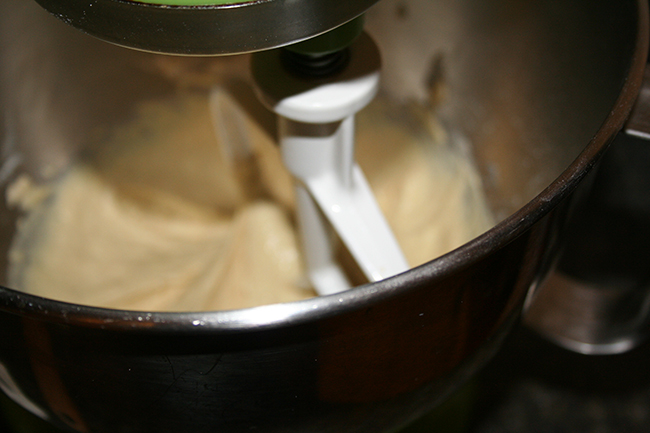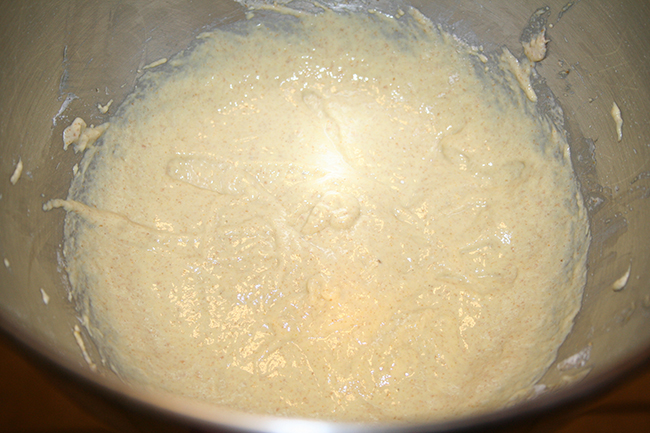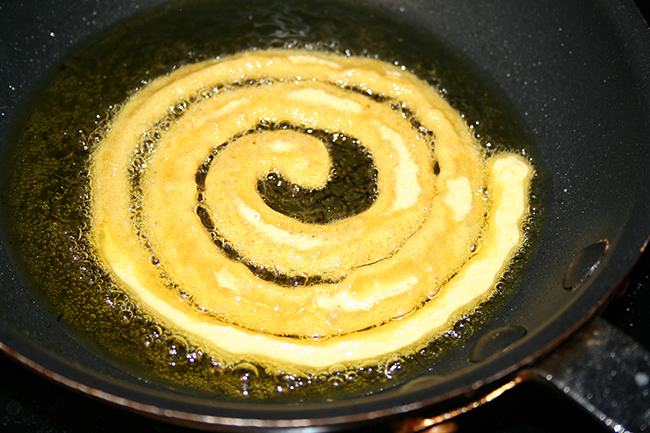If you’ve never heard of jalebi, it’s easy to sum up in a single phrase: Indian funnel cake. This traditional Indian confection bears more than a passing physical resemblance to the American fair food, but has a flavor all its own.

Photos via CakeSpy
Jalebi is a popular fried dough treat in India and surrounding countries.
Jalebi is composed of little portions of fried batter which are dipped in a sugar (and sometimes saffron-scented) syrup. It’s not hard to see why these crispy-crunchy and just a little sticky-sweet treats are so beloved! If you love a traditional American style funnel cake, you’ll enjoy discovering its international cousin, jalebi.

Homemade jalebi recipe
Makes about 24 small portions
Adapted from Veg Recipes of India
For the jalebis:
- 1 cup all-purpose flour
- 2 tablespoons chickpea flour
- 1/8 teaspoon ground turmeric
- Pinch baking soda
- Pinch salt
- ¾ cup water
For the syrup glaze:
- 1 cup granulated sugar
- ½ cup water
- 1/8 teaspoon turmeric
- 5 strands saffron (optional)
- Oil for deep frying
Step 1:
In a large bowl, combine the flours, turmeric and a pinch each of baking soda and salt. Give a quick stir to combine.

Step 2:
Add the water, and stir to combine and break up lumps. Mix vigorously for 3-4 minutes by hand (or for 1-2 minutes with a stand mixer fitted with the paddle attachment). The batter will be pourable but thick.

Step 3:
Cover the batter in the bowl with a slightly damp, clean kitchen towel or plastic wrap, and allow it to sit at room temperature for at least 5 hours, but as long as overnight. This fermentation period gives the jalebi its unique flavor. It’s normal to see some small bubbles along the top of the batter.

Step 4:
Near the end of the fermentation period, prepare your sugar syrup so that it’s ready to be applied as soon as you fry the jalebi batter.
Combine the sugar, water, turmeric and saffron in a heavy-bottomed saucepan. Heat on low until the sugar dissolves, and then increase the heat to medium, and cook until the sugar has thickened to the point where it seems hesitant to drip off of the back of a spoon. Remove from heat and set to the side.

Step 5:
Give the batter a stir and evaluate the consistency. You want it to be thick enough so that you can spoon or pipe it into swirls in the hot oil; if it seems too liquid, add a little more flour (up to 2 tablespoons). When satisfied with the consistency, load the batter into a plastic freezer bag and cut off the tip (or you can load it in a squeeze bottle)
Set a wire rack atop paper towels, so that you have a cooling rack for the jalebi once fried.
Step 6:
In a skillet, heat about 1″ of oil until it reaches 350 F (monitor the temperature with a candy thermometer).
Step 7:

Squeeze spirals of batter into the hot oil. Fry until golden on the first side (most likely less than a minute), and then flip using tongs and fry the second side to match.
Step 8:
Using tongs, remove the fried cakes; dip in the sugar syrup, then transfer to the cooling rack.
These fried morsels are best the same day made.
Recipe notes

A few strands of saffron add a unique flavor to the sugar syrup glaze. You may find that saffron is difficult and/or expensive to find. If it is prohibitive, simply omit it.
Traditional recipes will call for maida, which is a type of fine-textured, low-protein flour common in India. Some sources suggest substituting cake flour; I used all-purpose flour in this recipe and found the results pleasing.

Really appreciate the way you made this delicious jalebi. This is one of the most popular sweet recipe here in India during festival session. Thanks for sharing such a recipe here. Looking forward for more such recipes in future too.